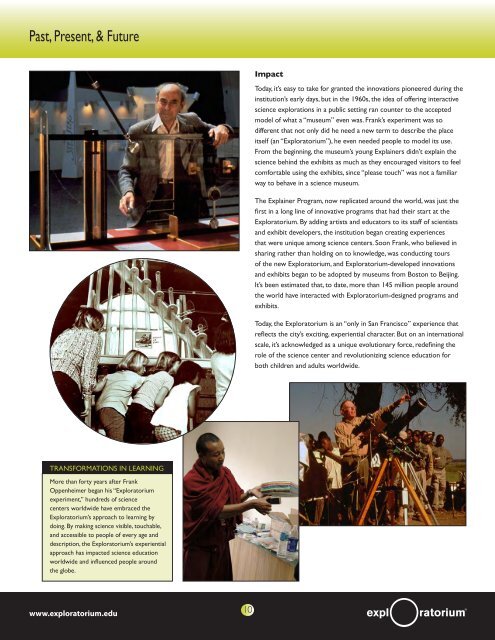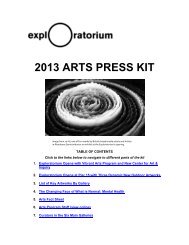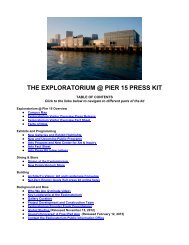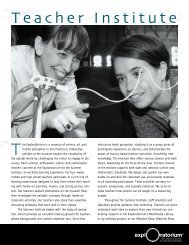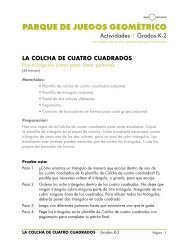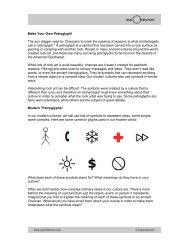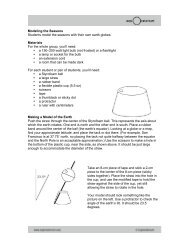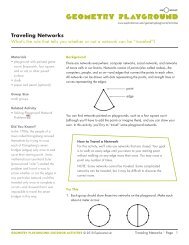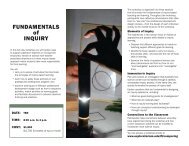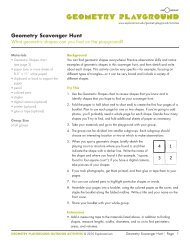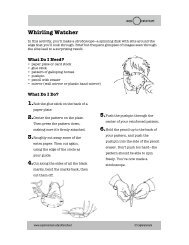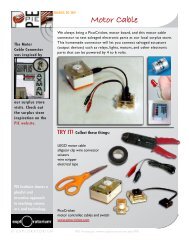Inside the - Exploratorium
Inside the - Exploratorium
Inside the - Exploratorium
Create successful ePaper yourself
Turn your PDF publications into a flip-book with our unique Google optimized e-Paper software.
Past, Present, & Future<br />
TRANSFORMATIONS IN LEARNING<br />
More than forty years after Frank<br />
Oppenheimer began his “<strong>Exploratorium</strong><br />
experiment,” hundreds of science<br />
centers worldwide have embraced <strong>the</strong><br />
<strong>Exploratorium</strong>’s approach to learning by<br />
doing. By making science visible, touchable,<br />
and accessible to people of every age and<br />
description, <strong>the</strong> <strong>Exploratorium</strong>’s experiential<br />
approach has impacted science education<br />
worldwide and influenced people around<br />
<strong>the</strong> globe.<br />
www.exploratorium.edu<br />
10<br />
Impact<br />
Today, it’s easy to take for granted <strong>the</strong> innovations pioneered during <strong>the</strong><br />
institution’s early days, but in <strong>the</strong> 1960s, <strong>the</strong> idea of offering interactive<br />
science explorations in a public setting ran counter to <strong>the</strong> accepted<br />
model of what a “museum” even was. Frank’s experiment was so<br />
different that not only did he need a new term to describe <strong>the</strong> place<br />
itself (an “<strong>Exploratorium</strong>”), he even needed people to model its use.<br />
From <strong>the</strong> beginning, <strong>the</strong> museum’s young Explainers didn’t explain <strong>the</strong><br />
science behind <strong>the</strong> exhibits as much as <strong>the</strong>y encouraged visitors to feel<br />
comfortable using <strong>the</strong> exhibits, since “please touch” was not a familiar<br />
way to behave in a science museum.<br />
The Explainer Program, now replicated around <strong>the</strong> world, was just <strong>the</strong><br />
first in a long line of innovative programs that had <strong>the</strong>ir start at <strong>the</strong><br />
<strong>Exploratorium</strong>. By adding artists and educators to its staff of scientists<br />
and exhibit developers, <strong>the</strong> institution began creating experiences<br />
that were unique among science centers. Soon Frank, who believed in<br />
sharing ra<strong>the</strong>r than holding on to knowledge, was conducting tours<br />
of <strong>the</strong> new <strong>Exploratorium</strong>, and <strong>Exploratorium</strong>-developed innovations<br />
and exhibits began to be adopted by museums from Boston to Beijing.<br />
It’s been estimated that, to date, more than 145 million people around<br />
<strong>the</strong> world have interacted with <strong>Exploratorium</strong>-designed programs and<br />
exhibits.<br />
Today, <strong>the</strong> <strong>Exploratorium</strong> is an “only in San Francisco” experience that<br />
reflects <strong>the</strong> city’s exciting, experiential character. But on an international<br />
scale, it’s acknowledged as a unique evolutionary force, redefining <strong>the</strong><br />
role of <strong>the</strong> science center and revolutionizing science education for<br />
both children and adults worldwide.


